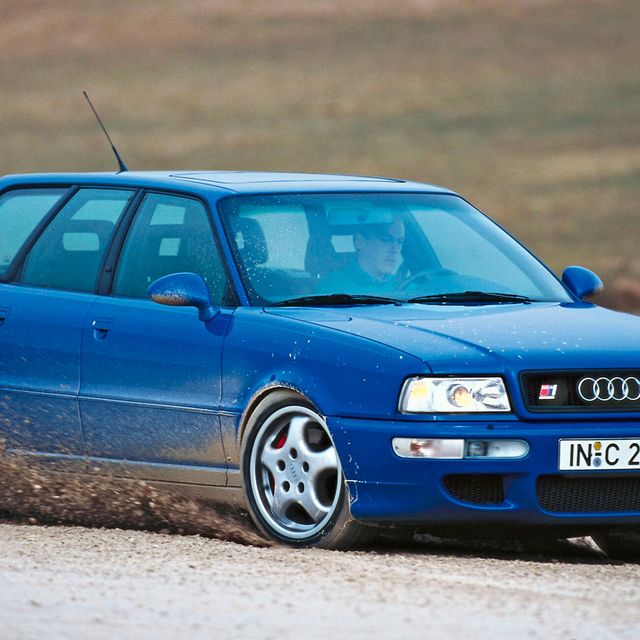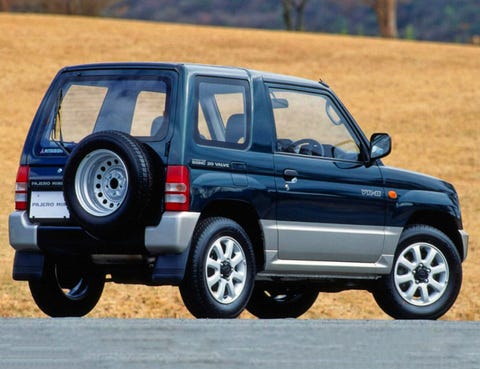New year, new you, new list of cars that can finally be brought to the United States. If you’re a car enthusiast, arguably the best part of rolling into a new year is the opportunity to purchase cars that were once forbidden fruit, made possible now that they’re a quarter of a century old. And trust me, 2019 has some real good shit in store, ranging from a Porsche-tuned station wagon to a few rally homologation specials to an apocalypse-ready minivan.
Keep in mind, you’ll have to wait until 25 years from the month your import was produced for it to be fully legal. (Read about the “25 Year Law” here.) But if you’ve been after any one of these wonderful obscurities, consider the wait nearly through.
Audi RS2 Avant
Arguably the most anticipated import car for 2019 will be the Audi RS2 Avant, grandfather to all hardcore sports wagons. Launched in March of 1994, the RS2 was a collaborative venture between Audi and Porsche and the harbinger of Audi’s insane “RS” cars. Based on the vanilla Audi 80, the RS2 was assembled at the same Porsche factory that made the legendary 959. It was bestowed with a turbocharged inline five-cylinder engine tuned by Porsche to produce well over 300 horsepower and sent to all four wheels via a six-speed manual gearbox. That glorious combination of running gear made a 0 to 60 mph sprint possible in under five seconds, which was supercar-rivaling acceleration at the time. Other goodies include Brembo brakes and Recaro sports seats.
Unfortunately, the RS2 was a particularly limited-run car, with fewer than 3,000 examples built. As such, the RS2 is already seeing massive demand in Europe, with prices extending well beyond $35,000 for a good example. So if you want one stateside next year, you’ll need fairly deep pockets.
Maserati Quattroporte IV
Most Maseratis of the ‘80s and ‘90s were weird, but also strangely desirable. The Quattroporte IV – a generation of the marque’s four-door we never saw stateside – is certainly no different. The car’s wedgy and angular styling was penned by Italian design legend Marcello Gandini (whose credits include the Lancia Stratos, Lamborghini Miura and De Tomaso Pantera). The engine powering it was a twin-turbo V6 (a couple of years later a twin-turbo V8 was also offered). That was good for a top speed of just over 160 mph and a 0 to 62 mph sprint in under six seconds, according to Maserati.
So it’s a reasonable performer then, with a luxurious interior, and it’s a bit of a rarity, to boot. Only some 2,400 Quattroporte IVs were made during its run between 1994 and 2000; it’d certainly stand out on American roads today. So if you want one, good news: you can find early examples in good condition for under $20,000. Bad news? It’s a 25-year-old, Italian exotic. Know what you’re getting into.
Toyota Celica GT-Four (ST205)
Think WRC homologation car and your mind probably conjures up images of Lancia Deltas and Audi Quattros sliding through the dirt and snow. But the Celica GT-Four ST205 is, arguably, one of the most underrated homologation specials to what is, arguably, the most infamous rally car of all time. In short, the Toyota Celica GT-Four competing in Group A rallying used a device that was able to bypass the turbo restrictor plate during competition yet could appear completely normal under inspection. This, supposedly, gave the car a 50 horsepower advantage over the competition. The technical explanation is longer and far more clever than just that – so much so that FIA president Max Mosley called it “the most sophisticated device I’ve ever seen in 30 years of motorsport.”
The road-going variant of the Group A car, introduced in February 1994, was just as much a friend, sporting an all-wheel-drive system, a 2.0-liter turbocharged four-cylinder producing 255 horsepower and a big-ass spoiler. It even featured all the plumbing needed to install an anti-lag system. It’s a little-known gem from the height of Toyota’s experimental phase, and that alone makes it worth seeking out (as if the rally-like handling and ear-piercing turbo noises weren’t enough).
Subaru WRX STi
While the rally-bred Subaru WRX STi has been available for a few generations in the U.S., the very early cars – the ones that first made Subaru a sensation with tuners and boy racers – was a Japan-only affair. The earliest WRX came into being in 1992, but the coveted variant warmed over by Subaru Technical International was introduced two years later. The first cars were essentially finished WRXs taken from the production line, then modified by STi. The 2.0-liter turbocharged four-pot received a modest power boost, from 240 horsepower to 250, while upgraded suspension and transmission components were added for good measure.
Mitsubishi Lancer Evo II
The first Lancer Evo has been legal in the U.S. for about two years now, but in 2019 you’ll be able to import that car’s successor. On the surface, there isn’t much to distinguish the Evo II from the original, mostly because the improvements made were incredibly subtle. That included a slightly lengthened wheelbase, wider tires and improved sway bars. Most notable, though, was a modest increase in power, now up to 252 horsepower over the original’s 244hp.
Mitsubishi Delica Space Gear
Mitsubishi’s off-road-ready third-generation Delica has been an import staple in the US for years now, but this year we’ll likely start seeing the car’s fourth-gen successor make its way stateside. In addition to the new “Space Gear” moniker, the fourth-gen Delica received smoother, more aerodynamic design language, perfect if you’re going for that “helicopter parenting in the end times” look. Though it lacks the edgier look of the third-gen, the Space Gear has a more refined interior, and it still retains — in 4WD guise — all the off-road underpinnings you’d need for an adventure: high-riding suspension, transfer case and a locking differential.
Mitsubishi Pajero Mini
Maybe you’ve fallen in love with the fourth-generation Jimny (we don’t blame you), but the idea of waiting a full 25 years for one is disparaging. For a replacement in the interim, might we suggest the Pajero Mini?
As the name suggests, the Pajero Mini takes inspiration from the legendary Mitsubishi Pajero SUV but is small enough to fit into Japan’s “Kei” class of microcars. That means you get a tiny 659cc engine and the car is even shorter than the modern Mini Cooper, but you get a 4WD system and transfer case for proper backwoods shenanigans.
Mitsubishi FTO
Clearly, 1994 was a big year for Mitsubishi, as it also saw the introduction of the FTO, the brand’s compact, FWD sports coupe. It’s an obscure little car, unless you spent a lot of time playing Grand Turismo as a kid, but was available with a revvy 2.0-liter V6 that pumped out 170 horsepower – or nearly 200hp in “GPX” trim (a smaller four-cylinder was the base option). Transmission options boil down to a five-speed manual or a four- or five-speed automatic with selectable gears that can “learn” your driving style and shift accordingly.
Nissan Rasheen
Compact crossovers are a dime a dozen these days, but if you want something small and practical that’s a bit more forward-thinking and quirky, the Nissan Rasheen might be your chariot. The Rasheen’s pseudo-retro styling looks inspired by the Wartburg 353 and smacks of Nissan’s oddball “Pike Factory” cars. Mechanically, there’s nothing particularly notable: it’s powered by a trio of small four-cylinders (1.5, 1.8 and 2.0-liter options were available) and Nissan’s ATTESA all-wheel-drive system. What is notable, however, is the option for plaid seating! Expect the earliest examples of the Rasheen to become eligible for import starting in November.
Peugeot 106 Rallye
This year is the year of the import rally car. In addition to the Celica GT-Four, WRX STi and Lancer Evo II, you’ll be able to import this: the Peugeot 106 Rallye, which was Peugeot’s homologation special for competing in 1,300cc class rally back in the day. The car’s humble (but high-revving) 1.3-liter engine only puts out around 100 horsepower, but with a stripped interior and a lightweight chassis, it only has to move around 1,800 pounds, making it a tossable little corner carver.
Note: Purchasing products through our links may earn us a portion of the sale, which supports our editorial team’s mission. Learn more here.


























